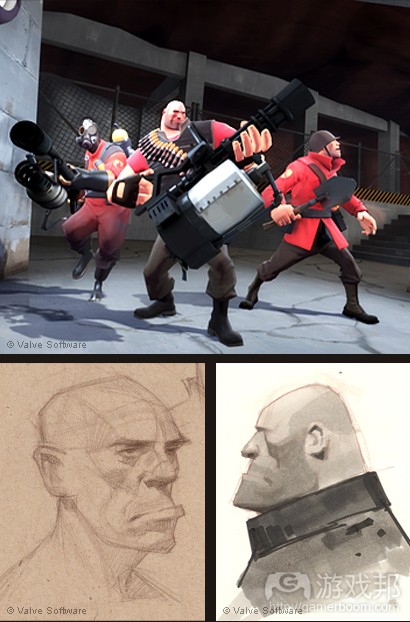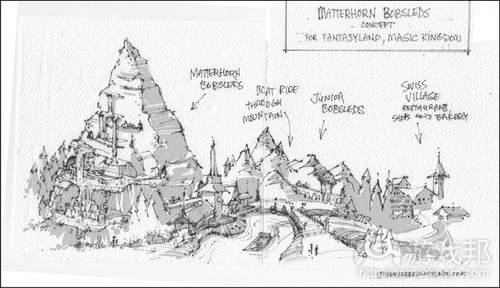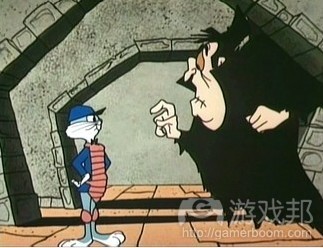论述创造3D动画效果的3点建议
作者:Kevin Tufano
3D动画似乎有些令人望而却步?我能体会如果没有这方面经验但想要成为美术设计师会是什么感觉。如果你依然基于线条进行思考,那么你多半无法适应。人类总是习惯于在思维局限范围内进行思考,这就是我们所接受的教育方式。但在工作中采用道教哲学能够帮你快速克服某天需要接触3D内容的畏惧心理。我的意思是:以相同方式看待2D和3D图像。
美术内容相当复杂。通常你会很长一段时间里徒劳无功,你会受到以此作为职业追求人士的打击。他们会说,“画家?我说的是真正的工作!”我们应该庆幸自己生活在这样一个年代,美术工作如今倍受重视,变得越发重要。电脑的诞生促使用户广泛接受科学和数学的可视化应用,因此动画逐渐在许多学科中扮演重要角色,包括教育和医学。
多数业余美术人员都是从二维视角着手,通过纸笔创作自己的作品。我们很容易理解为什么业余爱好者的作品会被完全排除在三维媒介之外,但我们可以通过很多方式克服这一问题。
1. 个人美术视角不要完全采用二维模式
还记得自己童年第一次接触绘画?你上网搜索如何画皮卡丘,你看到一个将角色分解成简单形状的略图?很多人会觉得这是另一种形式的描摹。如果你有发现,描摹通常会和原始作品如出一辙,这是个透视图。新手通常会将透视图局限看作是自己同纸张的统一关系,但其实透视图始于你脑中的构思。在美术世界,描摹通常不被推崇,因为它不利于画家构思自己的作品。我们通常觉得这会只会带来些许风格调整,但透视法是画家创作时应该遵循的主导哲学。
人体素描非常棘手,你无法一夜练就。它需要画家综合把握许多科学,例如人类学、肌肉学,甚至是心理学,进而确定脸部的细节元素。Norman Rockwell(游戏邦注:其美术风格在《军团要塞》中表现得淋漓尽致)主张以卡通风格呈现现实主义。业余观察者会将游戏的风格简单描述成现实主义,但作为艺术品,我觉得它更像是“人物讽刺画”。
如果你只是将脸部看作是系列线条,那么你就没有抓住要领。不要觉得铅笔画在3D作品的构思中有多么重要。
脸部不是处于平面状态。我相信你知道岁月痕迹在美术中的重要性。“你在人物的脸部添加更多线条,他看起来就会更老。”这大致是成立的。脸部是复杂的生物结构,它表现年龄的方式和身体其他部位不同,在美术中,朴素的脸庞更能够带给人年轻的感觉;在实际运用方面,在着眼于线条艺术的单个视角前先把握骨骼结构和肌肉机制这一点非常重要。
2. 在3D空间中创建立体模型
不要以此看待角色的动画发展潜能:
但是要从这样的视角入手。
3. 以关卡设计概念图的绘制方式绘制背景
我算不上优秀的背景美工,所以对此不妨持保留态度,但我觉得你可以在背景创作中也坚持这一方式。(本文为游戏邦/gamerboom.com编译,拒绝任何不保留版权的转载,如需转载请联系:游戏邦)
3D Animation: A Premeditative Outlook
by Kevin Tufano
3D animation seems pretty scary huh? I know how it feels to want to be an artist with no experience with the medium… It almost seems impossible to get acoustumed to if you’re still thinking with lines. It’s normal for the human psyche to think with absolute constraits of thought, that’s how we’re raised usually. Bare with me, but adopting a Taoist philosophy with your work could help you leaps and bounds overcome the daunting prospect of some day working with 3D materials. What I mean by this is this: think of your 2D art the same way you think of 3D art.
Art is hard. It’s usually thankless for a long time, you’re generally oppressd by people for wanting it as a carrer. “Artist?” they say, “I’m talking about a real job!” We should be thankful to live in a generation where now, more than ever, the artists work is appreciated and necessary in the work place. With the advent of computers giving a more more adopted sense to us as users the visual application of science and mathmatics, animation is useful to many many disciplines, including education and medicine.
Most amature artists start out in a 2 dimensional perspective, working with confinement of pencils and papers to produce their work. It’s easy to see how an amature could view their work as being entirely removed from the 3 dimensional medium, but there are lots of ways to overcome this.
1. Stop working with an absolute 2 dimension in your personal perspective of art.
Remember when you were first starting out as a kid? You’d go online and look up how to draw Pikachu and you’d be given an outline of breaking up the character into simple shapes? Most people stick with this simply as another method of tracing. If you’ll notice, traced work is missing a fundamental difference of the original work, which is perspective. A novice generally views prspective within the relationship of his comitment to the paper, but perspective actually starts inside of your mind. In the art world, tracing is generally discouraged since it’s detrimental to the artists conception of his work. People assume this lends itself only to style presets, but perspective is the msot governing philsoophy an artist takes when creating any drawing.
Life drawing is tricky, and it’s not something you learn overnight. it requires a LOT of study across many fields of science such as anthropology, myology, and even psychology when determing what is a relatively minute detail of the face. Norman Rockwell, the most explicit reference used in Team Fortress’s art style, is a cartoonish interpretation of realism. A casual observer would simply disect it as being realism, but as a work of art itself I feel it lends more appropriately to charicature, just a more masterful example.
If you simply look at the face itself as a series of lines you are missing the point. I really need to emphatsize discrediting your linework as being VERY important in conceptul apropriatism for 3D work, I would even go as far as to say in art in general.
The face is not flat. I’m sure you remember the value of age in the sense of art. “The more lines you add to a person’s face, the older he looks.” This is true in the vaugest sense. The face is a complex biological structure that lends itself to age differently than most of the body, and while in art a discreet apearance DOES tend to give the impression of youth, for exercises it’s more important to learn the valeus of the skeletal structure and muscular system before you get into anything of the sort of isolated perspective that line art takes you.
2. Work with your geometry in a 3D space.
Don’t think of your character’s potential for animation like this…
… But start thinking of them like this.
3. Draw backgrounds the same way you would draw level deign concept art.
I’m not a very good background artist, so take this with a grain of salt, but I figure that you can adopt this sensibility with backgrounds too.(Source:gamasutra)












































